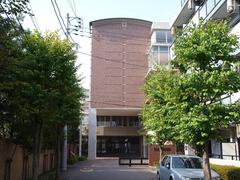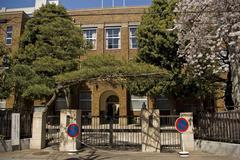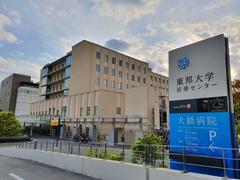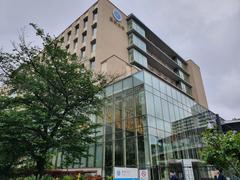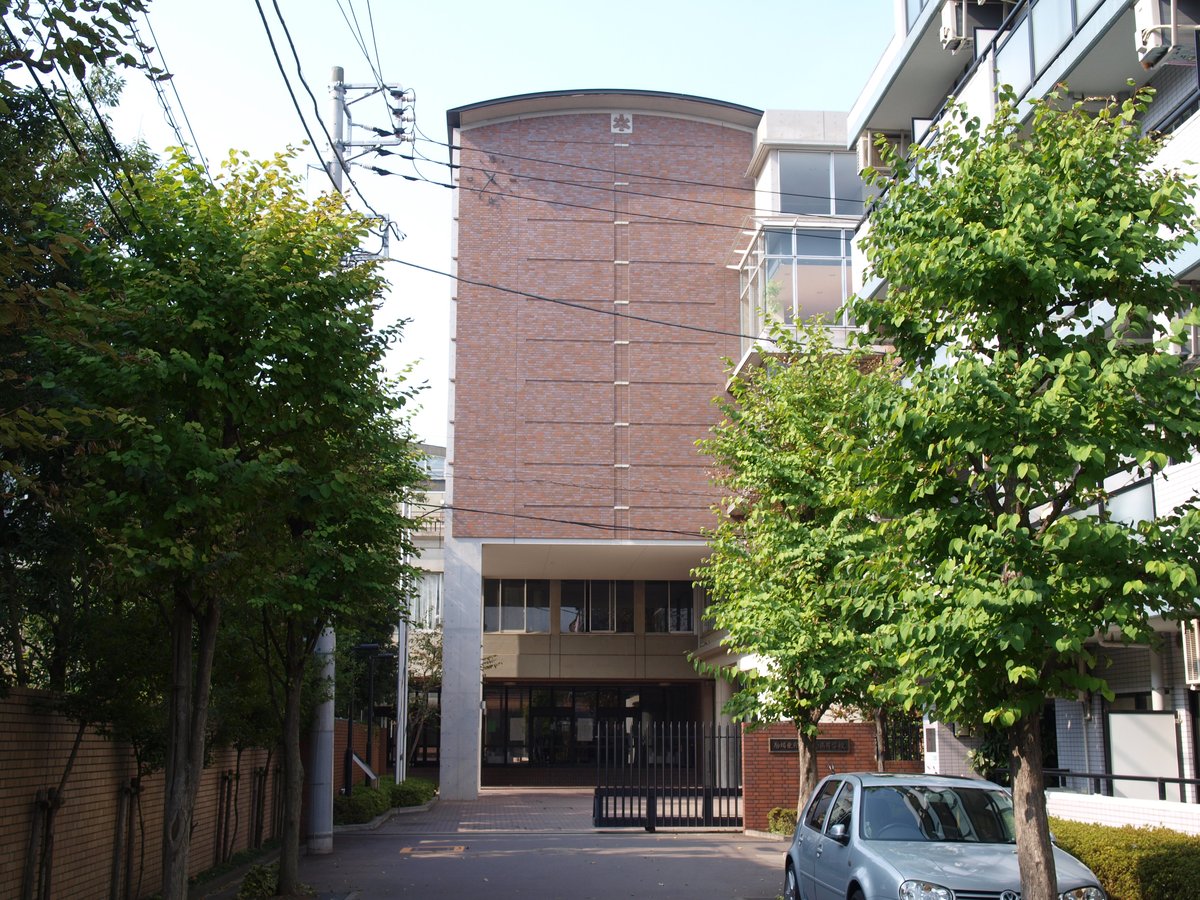
Toho University Tokyo Visiting Guide: History, Tickets, and Visitor Tips
Date: 14/06/2025
Introduction to Toho University Tokyo: History and Significance
Toho University, established in 1925 in Tokyo, Japan, is a distinguished institution renowned for its pioneering role in medical and life sciences education. It began as the Imperial Women’s Medical College, founded by brothers Yutaka and Susumu Nukada, making a significant contribution to women’s higher education in a field traditionally dominated by men. Over time, Toho University evolved into a coeducational university guided by its founding spirit: “Nature, Life, Man”—a philosophy emphasizing the integration of the natural world, human life, and scientific discovery. This ethos continues to shape the university’s academic mission and research agenda (Toho University History; Times Higher Education; Toho University Global).
Today, Toho University operates two main campuses: the Omori Campus in Tokyo, home to the Faculties of Medicine and Nursing and a major teaching hospital, and the Narashino Campus in Chiba, which houses the Faculties of Pharmaceutical Sciences, Science, and Health Science. Both campuses feature advanced research facilities, libraries, and clinical training centers, reflecting the university’s commitment to hands-on education and cutting-edge research (Toho University Global Campus Life; Toho University Graduate School of Pharmaceutical Sciences).
Visitors can explore the vibrant academic environment, cultural landmarks such as the Toho University Monument, and participate in guided tours during special events. Admission to campus grounds and the monument is free, with tours available by appointment (Visiting Toho University Monument).
This comprehensive guide provides prospective visitors, students, researchers, and tourists with essential information on Toho University’s history, campus highlights, visiting hours, accessibility, academic programs, and practical tips—helping you plan a meaningful and memorable visit to one of Tokyo’s premier educational institutions (Study Abroad Aide; Tokyo Transport Guide).
Table of Contents
- Introduction
- Historical Background of Toho University
- Campus Guide and Visiting Information
- Academic Faculties and Research
- Internationalization and Global Partnerships
- Student Body and Community
- Visiting Toho University Monument
- Campus Highlights and Facilities
- Hours, Tickets, and Tours
- Overview and Layout
- Academic and Research Facilities
- Medical and Clinical Facilities
- Student Life and Support
- Sports and Recreation
- Accessibility and Visitor Services
- Technology and Digital Resources
- Safety and Security
- Cultural and Community Engagement
- Visual and Interactive Resources
- Visiting Toho University: Hours, Access, Tickets, and Practical Tips
- Visiting Hours and Ticket Information
- Access and Transportation
- Entry and Policies
- Campus Navigation and Tours
- Seasonal Highlights
- Facilities and Amenities
- Etiquette and Cultural Considerations
- Events and Special Activities
- Nearby Attractions
- Safety and Security
- Language Support and Information
- FAQ
- Practical Tips
- Conclusion and Call to Action
- References
Historical Background of Toho University
Founding and Early Development
Toho University traces its roots to 1925, when Yutaka and Susumu Nukada established the Imperial Women’s Medical College in Omori, Tokyo. This groundbreaking initiative expanded opportunities for women in medicine, pharmaceutical sciences, and science—fields that were male-dominated in early 20th-century Japan. The college’s rapid expansion led to the creation of specialized branches in medical and pharmaceutical sciences, forming the foundation of the modern university (Wikipedia; Times Higher Education).
Postwar Reforms and Transition to Coeducation
Following World War II, Toho University restructured as a coeducational institution in 1950, reflecting broader social movements toward gender equality and educational reform. The Omori Campus in Tokyo became home to Medicine and Nursing, while Pharmaceutical Sciences and Science moved to the Narashino Campus in Chiba (Times Higher Education; Toho University Global).
The Founding Spirit: “Nature, Life, Man”
The university’s motto, “Nature, Life, Man,” underscores its vision of connecting natural sciences with human development and ethical inquiry. This core philosophy continues to inspire Toho University’s academic and research pursuits (Toho University Global).
Campus Guide and Visiting Information
Campus Locations and Facilities
- Omori Campus (Ōta, Tokyo): Focuses on Medicine and Nursing; includes a major university hospital and clinical training facilities. Approximately 20 minutes by taxi from Haneda Airport.
- Narashino Campus (Funabashi, Chiba): Houses Pharmaceutical Sciences, Science, and Health Science; features modern research centers and green spaces. About 45 minutes by train from Narita Airport.
Visiting Hours and Access
- General Hours: Campus grounds are open to visitors weekdays from 8:30 AM to 5:00 PM. Outdoor areas and gardens are accessible, while academic buildings require authorization.
- Tours: Guided campus tours are available by appointment, especially during open campus events (Toho University Global).
- Accessibility: Both campuses provide facilities for visitors with disabilities.
Nearby Attractions
The Omori area offers parks, shopping, and dining. Narashino is known for its recreational and retail options, providing a well-rounded visitor experience.
Academic Faculties and Research
Toho University includes Faculties of Medicine, Pharmaceutical Sciences, Science, and Nursing, along with strong graduate programs. The university is recognized for its achievements in clinical pharmacology, drug discovery, genetics, and neuroscience. Affiliated hospitals and research centers in Omori, Ohashi, and Sakura support both education and innovation (Toho University Graduate School of Pharmaceutical Sciences).
Internationalization and Global Partnerships
Toho University maintains global partnerships with institutions such as Chiang Mai University and Kunming Medical University, fostering exchange programs, joint research, and intensive English training. The International Communication Center plays a vital role in preparing students for global careers (Edarabia; Toho University Global).
Student Body and Community
In 2025, Toho University enrolled about 4,500 students, supported by 700 academic staff and over 3,300 administrative personnel. The university promotes inclusion, diversity, and vibrant campus life through extracurricular activities, international student support, and community engagement (Times Higher Education; Edarabia).
Visiting Toho University Monument
Introduction and Historical Background
The Toho University Monument is a significant symbol of the university’s nearly 100-year legacy in medical and life sciences education. Dedicated to founder Dr. Shusuke Kamijo, the monument reflects the institution’s commitment to academic excellence and compassionate healthcare (Visiting Toho University Monument).
Visiting Information
- Location: Main campus, easily accessible via Omori or Kamata stations.
- Hours: Open daily, 8:00 AM to 6:00 PM.
- Admission: Free. Guided tours available by appointment.
Cultural and Academic Significance
The monument serves as a venue for university ceremonies, academic celebrations, and commemorations, underscoring Toho University’s impact on Japanese healthcare and research.
Visitor Tips
- Maintain a respectful demeanor at the monument.
- Photography is allowed; optimal lighting is in the morning or late afternoon.
- Nearby facilities include libraries, cafes, and sports amenities.
Nearby Attractions
- Omori Furusato-no-Hamabe Park: Waterfront relaxation.
- Ikegami Honmon-ji Temple: Architectural and cultural interest.
- Tokyo Bay: Dining and entertainment.
Accessibility
The monument and campus are wheelchair accessible, and assistance is available upon request.
Special Events and Guided Tours
Annual events and guided tours highlight the university’s history and achievements. Book via the official website.
Visuals and Media
Virtual tours and photo galleries are available online, offering insights into the monument’s history and campus environment.
Campus Highlights and Facilities
Hours, Tickets, and Tours
Campus grounds are open weekdays 8:30 AM–5:00 PM. No tickets required for general access, but guided tours should be scheduled in advance.
Overview and Layout
The Omori campus combines modern and traditional architecture, green spaces, and comprehensive educational facilities, supporting over 8,400 students.
Academic and Research Facilities
- Faculty Buildings: Medicine, Pharmaceutical Sciences, Science, and Nursing are equipped with advanced classrooms and labs.
- Research Centers: Specialize in molecular biology, pharmacology, and clinical studies.
- Libraries: Extensive collections, study zones, and digital resources.
Medical and Clinical Facilities
- University Hospital: Over 900 beds, teaching and public healthcare services.
- Simulation Centers: Offer essential clinical skills training.
Student Life and Support
- Centers and Lounges: Spaces for cultural exchange and student activities.
- Dining: Multiple cafeterias with Japanese and international cuisine.
- Accommodation: University assists with off-campus housing and affiliated residences.
Sports and Recreation
- Athletic Facilities: Gymnasium, fitness center, and outdoor fields.
- Clubs: Wide range of student organizations.
Accessibility and Visitor Services
- Facilities: Ramps, elevators, and bilingual signage.
- Information Centers: Maps, brochures, and multilingual assistance.
- Transportation: Easily accessible by public transit with nearby train and subway stations.
Technology and Digital Resources
- Wi-Fi: Campus-wide access.
- IT Support: Digital learning platforms and assistance available.
Safety and Security
- Campus Security: 24/7 patrols and emergency systems.
- Health Services: On-campus clinics and counseling.
Cultural and Community Engagement
- Events: Academic conferences, cultural festivals, and public lectures.
- Outreach: Health education, sustainability, and disaster preparedness initiatives.
Visual and Interactive Resources
Virtual tours and high-quality images are available on the official website.
Visiting Toho University: Hours, Access, Tickets, and Practical Tips
Visiting Hours and Ticket Information
Campus is open to the public weekdays from 8:30 AM to 5:00 PM. No entrance fee for outdoor spaces; guided tours and special facility access require advance booking (official website).
Accessing Toho University: Location and Transportation
- By Train: 10-minute walk from Omori Station (JR Keihin-Tohoku Line).
- By Subway: Heiwajima Station (Keikyu Main Line) with bus or taxi connection (Tokyo Transport Guide).
- IC Cards: Use Suica or Pasmo for convenient travel (Tokyo Candies: Getting Around).
Entry and Visitor Policies
Outdoor areas are generally accessible; academic buildings are restricted. Check the university calendar for special closures or events.
Campus Navigation and Tours
The campus is walkable with bilingual signage. Maps are available at the main gate and online. Guided tours can be arranged; cherry blossom and autumn foliage seasons are especially scenic.
Seasonal Highlights
- Spring: Hanami under cherry blossoms.
- Autumn: Colorful foliage.
Facilities and Amenities
- Dining: Cafeterias and cafes on campus; diverse restaurants in Omori (Away to the City: Tokyo Food Guide).
- Restrooms and Accessibility: Facilities throughout campus, fully accessible.
- Wi-Fi: Available in select areas; portable Wi-Fi devices can be rented (Japan Experience: Internet Access).
Etiquette and Cultural Considerations
Respect quiet areas, adhere to smoking rules, dispose of trash properly, and dress appropriately. Outdoor photography is allowed; seek permission for indoor photos or images of individuals.
Events and Special Activities
Public lectures, open campus days, and cultural festivals are held regularly; check the news page for updates.
Nearby Attractions
- Shinagawa Aquarium: Family-friendly.
- Heiwajima Park: Seasonal blooms.
- Ōmori Shell Mounds Museum: Archaeological exhibits.
Safety and Security
Safe, residential area with campus security patrols. Emergency contacts and medical services are available.
Language Support and Information
English signage is present in key locations; information desks offer basic English support. Consider translation apps or local guides (Japan Experience: Tours).
Frequently Asked Questions (FAQ)
Q: How can I visit Toho University?
A: Schedule campus tours in advance or attend open campus events.
Q: Are guided tours available?
A: Yes, by appointment during special events.
Q: What are the admission requirements?
A: Varies by faculty and program; check the admissions webpage.
Q: Is the campus accessible for visitors with disabilities?
A: Yes, fully accessible.
Q: What transportation options are available?
A: Omori Campus: 10-minute walk from Omori Station; Narashino Campus: 45 minutes by train from Narita Airport.
Q: Is there an entrance fee?
A: No, campus grounds and gardens are free to access.
Q: Can I take photographs?
A: Yes, outdoors; permission needed indoors or for photographing people.
Practical Tips for a Memorable Visit
- Visit during spring or autumn for scenic beauty.
- Arrive early to enjoy a tranquil atmosphere.
- Use public transit and IC cards for convenience.
- Check the official website for the latest updates.
- Respect campus rules and academic activities.
Conclusion and Call to Action
Toho University’s blend of academic excellence, historical significance, and vibrant community makes it a rewarding destination for visitors, students, and researchers alike. Plan your visit by scheduling a guided tour, participating in university events, or exploring nearby Tokyo attractions. Stay up to date with the latest news by visiting the official Toho University website and downloading the Audiala app for convenient access to university information and educational content.
Summary of Key Points and Visitor Recommendations
Toho University stands out as a pioneering institution in medical and life sciences, with a legacy rooted in empowering women and advancing Japanese education and research. Its campuses in Tokyo and Chiba offer outstanding facilities, seasonal beauty, and a welcoming environment. The Toho University Monument serves as a cultural and academic landmark, and visitors can benefit from free access, guided tours, and diverse campus amenities (Wikipedia; Times Higher Education; Toho University Monument Guide; Edarabia).
For a seamless visit, plan your trip around open campus events, utilize Tokyo’s efficient transport system (Tokyo Candies), and explore both the academic and cultural highlights of the area. Download the Audiala app for easy access to university news and educational content.
References and Further Reading
- Toho University, 2024, Wikipedia
- Toho University Rankings, 2024, Times Higher Education
- Toho University Global Campus Life, 2024
- Toho University Graduate School of Pharmaceutical Sciences, 2024
- Visiting Toho University Monument, 2024
- Study Abroad Aide: Toho University Overview, 2024
- Tokyo Transport Guide, 2024
- Edarabia: Toho University Tokyo Japan, 2024
- Tokyo Candies: Getting Around Tokyo, 2024
- Away to the City: Tokyo Food Guide
- Japan Experience: Internet Access
- Japan Experience: Tours
- Official Toho University Website
- Audiala App
